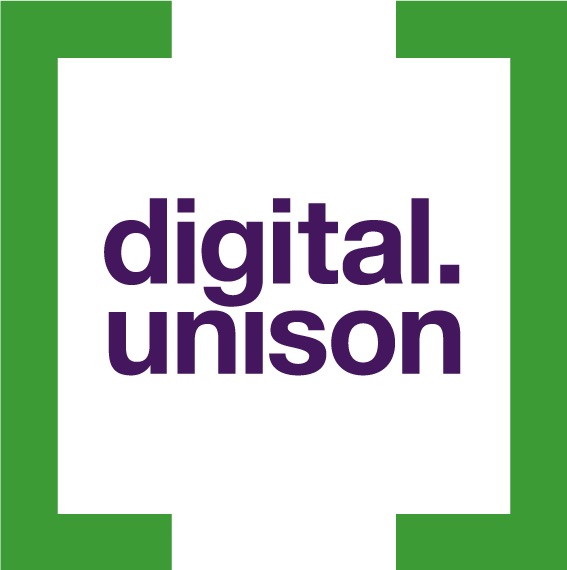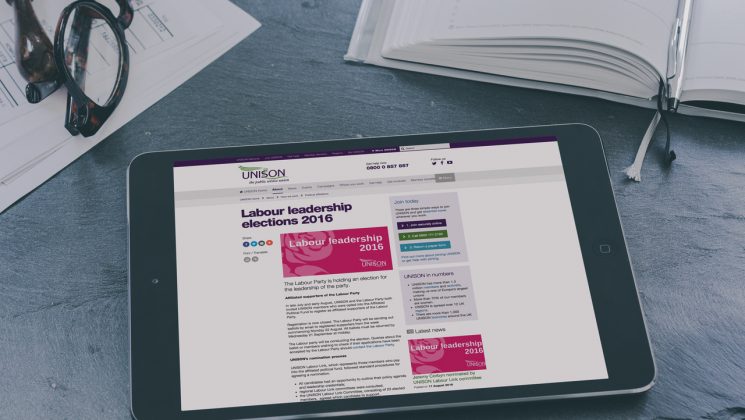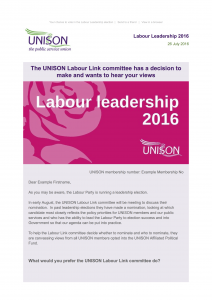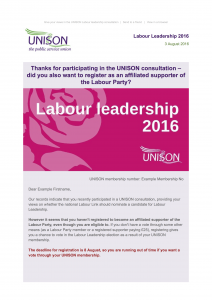It is fair to say we weren’t really expecting to be working on another Labour leadership process this summer. Lots of projects were in the pipelines, lots of other activities planned.
But, when it became clear that the leadership election was on, we had to put a lot of this to one side and use the opportunity to try out some new forms of digital engagement.
As the saying goes – if life gives you lemons, make lemonade.
What had changed since 2015
Last year, we’d worked really hard to give eligible UNISON members a quick and easy digital process to registering as an ‘affiliated supporter’ of the Labour Party – this gave those registered a chance to vote in the leadership election.
We’d created ‘one-click emails’, where anyone who clicked a big button in the email effectively agreed to the terms and conditions and was registered.
It was pretty successful – 20,000 people registered at the click of a button and a number of other unions copied our approach.
The 2016 election was a slightly more complicated beast for a few reasons:
- The timeline was very tight: we had just a few weeks to get people registered – from mid-July to early August.
- The eligibility criteria were more complicated: only UNISON members who’d been a member before 13 January 2016 were allowed to become affiliated supporters.
- The political environment was more tense: any digital engagement initiative would come under greater scrutiny on social media and potentially in the wider media too.
The recipe for a perfect lemonade
We set ourselves a goal of delivering a member engagement process that was:
- Inclusive: We could see the level of passion and interest in the election from many of our members on social media, and we wanted to channel that into greater engagement with the union and its processes – allowing members to feel part of the discussions at every stage.
- Targeted: Every time we engage members – via email, social media or any other tool – we have to think hard about which segment of members to engage. If we engaged 1.3m members all the time we’d turn many uninterested members off, and reduce our chances of success when the time comes that we really need them to engage. The flip-side is that for those we targeted we wanted the highest possible engagement rates – so effective targeting of communications was key.
- Informative: Many members were keen to know whether or not they were eligible to register as affiliated supporters – a clearer and more informative online process would mean fewer calls ending up at our call centre.
- Accessible: The 2015 registration process had only been accessible to members with an email. Other past systems had required a full registration process with usernames and passwords to use. We needed something that worked even if we didn’t have emails and had no login forms to put people off participating.
- Trusted: We needed to ensure one member one vote and also the anonymity of that vote, something we have not been able to ensure with absolute certainty in previous online consultations on other issues.
- Resilient: With many eyes watching us – including the media – we needed to ensure anything we built didn’t fall over.
- Cost effective: We didn’t have any budget so we needed to be able to use the tools already at our disposal to deliver everything – and do it in days rather than weeks.
What we put in place
An online consultation of members
We were proud to support UNISON’s first ever national online consultation of affiliated political fund payers, which asked whether the Labour Link Committee should nominate a candidate – and who they should nominate if they did.
The digital team offered early on to run an online consultative ballot, as we knew we had the technology to achieve a more transparent, secure and trustworthy process than we’ve ever been able to run before.
Even though our decision-making process officially means a committee makes the decision, we wanted to make sure members had the chance to have their input into that committee too.
In the end, over 20,000 members took part in the consultation – and there was lots of really great feedback from members keen to have a chance to feed into the decision.
Thanks @unisontweets for giving us a say on who we nominate for LP leader. Won't be whinging whatever the result
— (((Jeffrey Baxter))) (@Baxter7Jeffrey) August 10, 2016
Pleased that @unisontweets is consulting members on #LabourLeadership – Link to check if you're eligible & vote here https://t.co/xy3SgMLIkS
— Chris Elmore MP (@CPJElmore) July 29, 2016
The ‘affiliated supporter’ registration tool
Combined with the online consultation, we built a tool using a combination of SurveyGizmo (our new survey tool) and Salesforce (our digital contact relationship management, which is synched regularly with our membership database, RMS).
This allowed members to quickly and easily check whether they met Labour’s rules and to register if they did.
It also gave them a chance to update their email, mobile number and address while they were at it. The tool was used 11,000 times.
A targeted email campaign to drive people to the consultation and/or registration
We used the automated links between our new email tool, Adestra MessageFocus, and our Salesforce member data to generate a number of different emails – each targeted at different groups.
For example, when we sent reminders we created the following email segments:
- People who had neither participated in the consultation nor registered as affiliated supporters, despite being eligible.
- People who had participated in the consultation but not registered as affiliated supporters, despite being eligible.
- People who had registered as affiliated supporters but not participated in the consultation.
- People who had not participated in the consultation and were not eligible to register as affiliated supporters.
We also worked hard to use the emails to get as many people participating in the consultation, by including the first question within the email itself (click to answer).
The new @UNISONpolitics Twitter account
Twitter is a great place to engage people on political issues and we know many of our most politically active members are on Twitter.
We wanted to have a place to let people know about our parliamentary work and local and regional political work without bombarding followers of our main Twitter account who may not be quite so interested in politics.
Clearly this account has a longer shelf-life than just the Labour leadership election but it was very useful to launch it at this point to help build a following and have a slightly separate space to give more information on what UNISON was doing.
Getting information out quickly, responding to queries (also through our @UNISONdigital account when it related to the registration tool) was well received by our members, politicians and journalists.
UNISON consultative ballot of affiliated members
Participated: 20,190
Corbyn: 58%
Smith: 42%
Results https://t.co/HPTU3a1VzH— UNISON politics (@UNISONpolitics) August 11, 2016
@UNISONdigital you have made a political anorak happy.
— Patrick Wintour (@patrickwintour) August 11, 2016
A website portal with the latest information and resources
This isn’t a new thing for us, but it is essential: the website is the first place people will check to get the answers to their questions so keeping it up to date with clear,consistent and comprehensive advice is essential.
Some slightly sour notes
Nothing ever goes perfectly, and we definitely learned a few lessons from the work.
Technical and human errors
This was the first time we’d used the integration between SurveyGizmo and Salesforce and there is a limit of 3,600 connections in each Salesforce account every hour – one a second.
We went over that, and as a result some members were unable to register their preference for a few hours. We put in some workarounds (we now use a few different Salesforce accounts to up the limits) and are talking to both Salesforce and SurveyGizmo about longer-term changes that will avoid this issue completely in future.
We also made a couple of mistakes within some emails sent to smaller segments of members, where information was not sent to the correct members or a link didn’t work.
This is a reminder of how important it is to get everything double-checked when working with a large number of data segments.
The mistakes could be corrected with follow-up emails, but each occurance added additional and unnecessary work that better checking up-front would’ve saved.
We would’ve hoped for more participation
Though we tried hard to increase turnout the reality is that we were limited by not having enough time – in just over a week we got 10% turnout of people who we had an email for.
We have previously been able to achieve between 30% and 40% turnout in other similar engagement programmes.
With more time ,we would’ve been able to push more out through other routes such as postcards and the like. However, the reality is that in the middle of the summer holidays, it was always going to be a little harder.
Would you like the Labour Link committee to nominate a candidate in the forthcoming Labour Leadership election?
//
You can’t please all the people, all of the time
We received a lot of positive feedback from members for embarking on a consultation of members.
The consultation was for affiliated political fund payers only, as the decision to nominate is that of the committee that oversees that fund.
This focus felt like the right decision for the digital team too, as it focuses our engagement efforts on the members who pay into the Labour Party so who are obviously highly interested in its future.
However, when the results were announced there were a number of general political fund payers who were not consulted and felt that they should have been.
It is probably impossible to have a process that makes everyone happy: for instance, in the GMB there were members who felt it wrong that all members had been consulted rather than the most relevant ones.
Did we hit the mark?
Though we hadn’t planned for it, the work we’ve undertaken in the Labour leadership campaign has massively improved our digital capabilities and experience.
We’ve tested and used new tools – and combinations of new tools – that should allow us to deliver better consultative ballots or similar engagements in future.
Every new campaign we run teaches us more about how we can best use Twitter and Facebook to have more discussions with our members and, hopefully, help them see UNISON as a place that they can engage with on a digital level as well as within their branches or through call centres – this was no exception.
And finally, though we could always hope for higher numbers, the turnout was not poor and gives us a great baseline to improve on in future.





